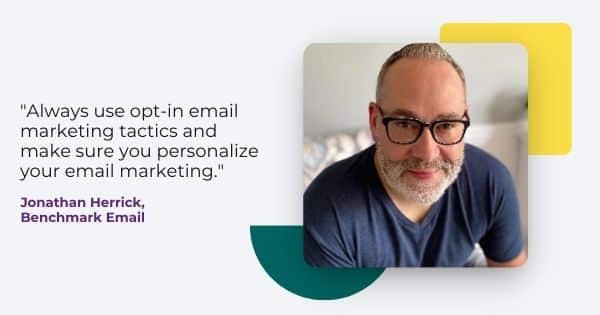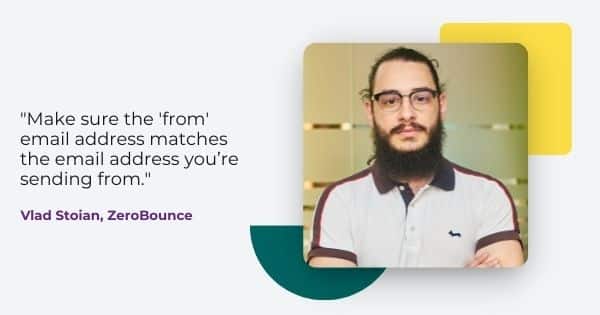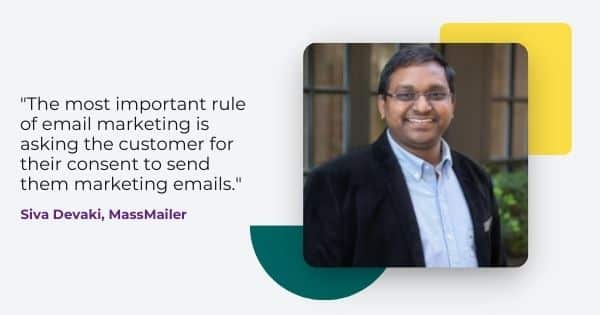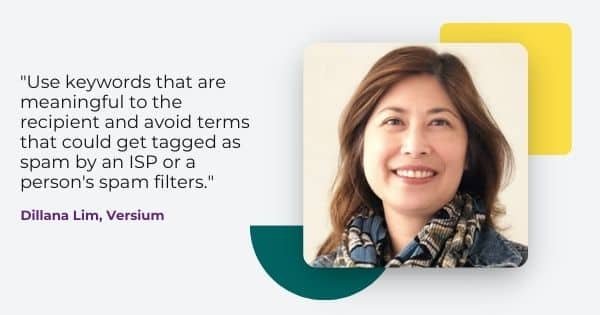
Why Do Emails Go to Spam? Here Are the Most Common Reasons – And the Fix
Email marketing only works if you’re hitting the inbox. If your emails are going to spam, you’re only wasting time and other valuable resources.
A lot of things can cause emails to land in spam, and they’re not always so easy to figure out. What are the causes – and what can you do?
I asked some of the most knowledgeable professionals in the email space to answer the question.
Experts from GetResponse, Benchmark Email, Dyspatch, MassMailer, and Versium gave us some great pointers.
Email geeks Liz Willits and Emily Ryan have sent millions of emails on behalf of their clients. They joined to shed even more light on the topic.
And, of course, you’ll also hear from ZeroBounce’s own deliverability expert Vlad Stoian.
So, why do emails go to spam?
Let’s see what these pros have to say.

Micha? Leszczy?ski, GetResponse: “Not many marketers like to prune their lists.”
“There are many reasons why emails land in the spam folder. List quality, technical setup, and not using a company domain are just a few things that affect your deliverability.
But the bigger problem I see is engagement. It’s getting harder to track engagement (thanks, Apple!). And with average email click-through rates (CTRs) being around 2-3%, it’s hard to say what your recipients are genuinely interested in.
Plus, let’s be honest. Not many marketers like to prune their lists and actively clean them.
Now, what’s the solution? If I had to place a bet, I’d go with automation, progressive profiling, and, most importantly, being transparent about the data you track and use.”
—Micha? Leszczy?ski, Head of Content Marketing & Partnerships at GetResponse

Jonathan Herrick, Benchmark Email: “Being marked as spam will hurt your deliverability”
“Being marked as spam can do a series of unfortunate things that will hurt your email deliverability in the long run. And if your emails are unable to make it to the inbox, then your strategy is pretty much dead in the water.
Luckily, you can do things that will help ensure you avoid the spam folder. There are a series of words you can avoid using that will help. But the biggest tip I can offer is two-fold: always use opt-in email marketing tactics and make sure you personalize your email marketing.
When you use opt-in forms, you’re not only compliant but also building an email list of subscribers who want to hear from you. These are people that look forward to your emails and therefore, are less likely to mark you as spam.
When you pair opt-in email marketing with a personalized approach, you’re showing your subscribers that you understand them. You’re able to send them content, resources, offers, and promotions that align with their needs, which they’ll come to appreciate.
And when they know the email they’re receiving will offer them something of value or solve an immediate problem they have, they wouldn’t think of sending it to the spam folder.”
—Jonathan Herrick, CEO at Benchmark Email

Vlad Stoian, ZeroBounce: “Nothing will send you to spam faster than a bad IP reputation.”
“There are a variety of poor practices you can avoid to prevent emails from landing in the spam folder.
These factors are automatically identified by Internet Service Providers (ISPs) and email services. There are mainly four things an email marketer can do to avoid having their emails go to spam.
Proper DKIM, SPF, DMARC authentication
It provides the recipient servers a way to authenticate who you say you are. Make sure the “from” email address matches the email address you’re sending from. Also, include your physical address in the email footer.
Email list quality
By attempting to contact nonexistent addresses, you’re causing spam services to perceive you as a spammer. Also, by sending unrequested emails, you run the risk of your emails being marked as spam. ISPs won’t support you in reaching the inbox.
The content of your email
ISPs use automatic filters to identify spam-like content within emails and to filter them into the spam folder. This subject is more complex and can vary depending on the email service provider, but here are some things to avoid:
- misleading headers
- USING ALL CAPS
- excessive use of exclamation marks
- a high ratio of images/emojis to text
- a high number of attachments
- specific words or phrases such as Act now, While stock lasts, Free gift, Incredible deal, and so on. On their own, they’re not damaging, but using a high number of them will increase your spam score. If you go over the threshold, your email will land email in the spam folder.
IP Reputation
Nothing will send you to spam faster than a bad IP reputation. If your IPs have a high bounce rate and a reputation for sending spam, forget about hitting the inbox. What’s more, you could be completely blocked and not even make it to the junk folder.”
—Vlad Stoian, Customer Support at ZeroBounce

Matt Harris, Dyspatch: “You don’t use double opt-in.”
“Spam algorithms have one goal: deliver emails people want to receive. When your emails aren’t getting any engagement (opens, clicks, etc.), that’s a sign they may not be wanted. If you don’t use double opt-in, that’s a sign your emails may not be trustworthy.
Spammy words (like earn extra cash, buy direct, etc.) may trigger some spam filters — although more advanced algorithms have moved away from keyword-based filters.
And if you send emails that keep bouncing, that’s a sign you may have purchased a list. It’s a big red flag to algorithms and can seriously impact your deliverability long-term.
Moral of the story? Practice permission-based marketing, send quality content your users actually want, and make sure you’re monitoring your list for hard and soft bounces.”
— Matt Harris, CEO, and Founder at Dyspatch

Emily Ryan, Westfield Creative: “You’re not sending email consistently”
“The best analogy I ever heard is that getting your email out of Spam is a lot like improving your credit score. There are many factors involved in why your email may land in that dreaded folder and you can make small adjustments to improve your overall sender reputation.
Spam filters are very smart, but there are plenty of ways to get yourself into good inbox placement.
Below are a few reasons why your email could land in Spam. And yes, there are cases when emails that shouldn’t be landing in Spam – do, so it’s important to know what could cause that.
- You’re sending to subscribers who never signed up for your email list. (They did not “opt-in.”)
- Your email is composed of all images. This is a big one that can trigger spam filters.
- Your email’s subject line has spam trigger words (like “free” and “buy” and “call”).
- Your domain is not authenticated in your ESP.
- You have very low open and click rates from past emails you’ve sent. This tells Gmail that people don’t engage with your emails.
- You have a lot of emails that bounce every time you send an email.
- You have invalid email addresses on your email list (and maybe didn’t know it).
- You never “warmed up” your IP address when you started sending email campaigns.
- Your subject lines are “clickbait” or are misleading.
- You’re not sending emails consistently.
- You’re sending to emails that are inactive.
There are so many reasons as to why your email might end up in Spam. Here is a great resource from ZeroBounce which gives a detailed list of things you should make sure to check.
Deliverability must be the main priority for successful email marketing. Why spend time creating emails if they end up in a folder that no one will ever see?
We always recommend people take a good look at their sender reputation before trying to improve other metrics.”
—Emily Ryan, Mailchimp Pro Partner, Email Strategist and Co-founder at Westfield Creative

Siva Devaki, MassMailer: “The email subject is misleading”
“Email marketing is big, which is why you want your emails to make it to the recipients’ inboxes instead of their spam folders. There are various reasons why emails land in the spam, which is always counterproductive to marketing.
The marketer doesn’t have consent
The most important rule of email marketing is asking the customer for their consent to send them marketing emails. Often, marketers tend to purchase a list of email subscribers and initiate a bulk email campaign for marketing to them.
The IP address is questionable
In case the marketer is subscribed to a marketing service provider, chances are they’re letting the client use a shared IP address. In essence, this means that some other client – with questionable practices – is also using the same IP address for email marketing.
The email subject is misleading
It isn’t ethical to lure users into opening an email by using a subject line that misleads them.
—Siva Devaki, Co-CEO at MassMailer

Liz Willits: “You’re sending unexpected email content.”
While this isn’t an all-encompassing list, here are a few common reasons your emails may be going to the spam folder:
Your email click-through rates are low.
Internet service providers (ISPs) – like Gmail – interpret low click-through rates as a sign your emails aren’t wanted. And they may deliver future emails to the spam folder.
You’re sending unexpected email content.
This could be because you didn’t clearly explain what kind of content people will get when they subscribe. Or you did tell them, and you’re sending content outside those expectations. Make sure to set clear expectations and then deliver on those expectations.
You’re sending unwanted email content.
Maybe you purchased your email list. Or, you’re just sending content that isn’t valuable or useful to your audience. This impacts your click-through rate. It can also cause a high percentage of unsubscribes and spam complaints.”
—Liz Willits, Email and Content Marketing Specialist

Dillana Lim, Versium: “Low engagement can land you in spam.”
“High engagement is key to email marketing success, and low engagement can land you in spam. In addition to maintaining clean and updated lists, there are a few simple rules marketers can follow to improve their online reputation and avoid emails being blacklisted or marked as spam.
- When ramping up a new email campaign, make sure to focus early waves on recipients who have shown high engagement in the past. Those who’ve interacted with your emails in the past are likely to do so again.
- Use keywords that are meaningful to the recipient and avoid terms that could get tagged as spam by an ISP or a person’s spam filters.
- Ensure there’s a clear message and call-to-action in your email. High-quality, customized content focused on verticals and segments will drive higher engagement overall.”
—Dillana Lim, CEO at Versium
There’s one more thing…
Something I do frequently – that almost none of your email subscribers will – is look in my spam folder. What do I find there? Well, mostly it’s just obvious spam.
Sometimes, I’ll see personal emails from people I know. What I find often are newsletters I signed up for that started being sent there.
A good exercise is to look at the marketing emails in your junk folder and ask yourself: Why did they get there? Maybe it’s because you didn’t engage with that newsletter. It could be because although you stayed on the list, they never actually got your permission in the first place.
The things you can learn from doing this is what behaviors or mistakes are landing those emails in spam. It may help you prevent your emails from going down that same path!
P.S. Suspicious that your emails are going to spam? It could be that your list may need a scrub. Start a ZeroBounce account and validate 100 email addresses free – every month.






